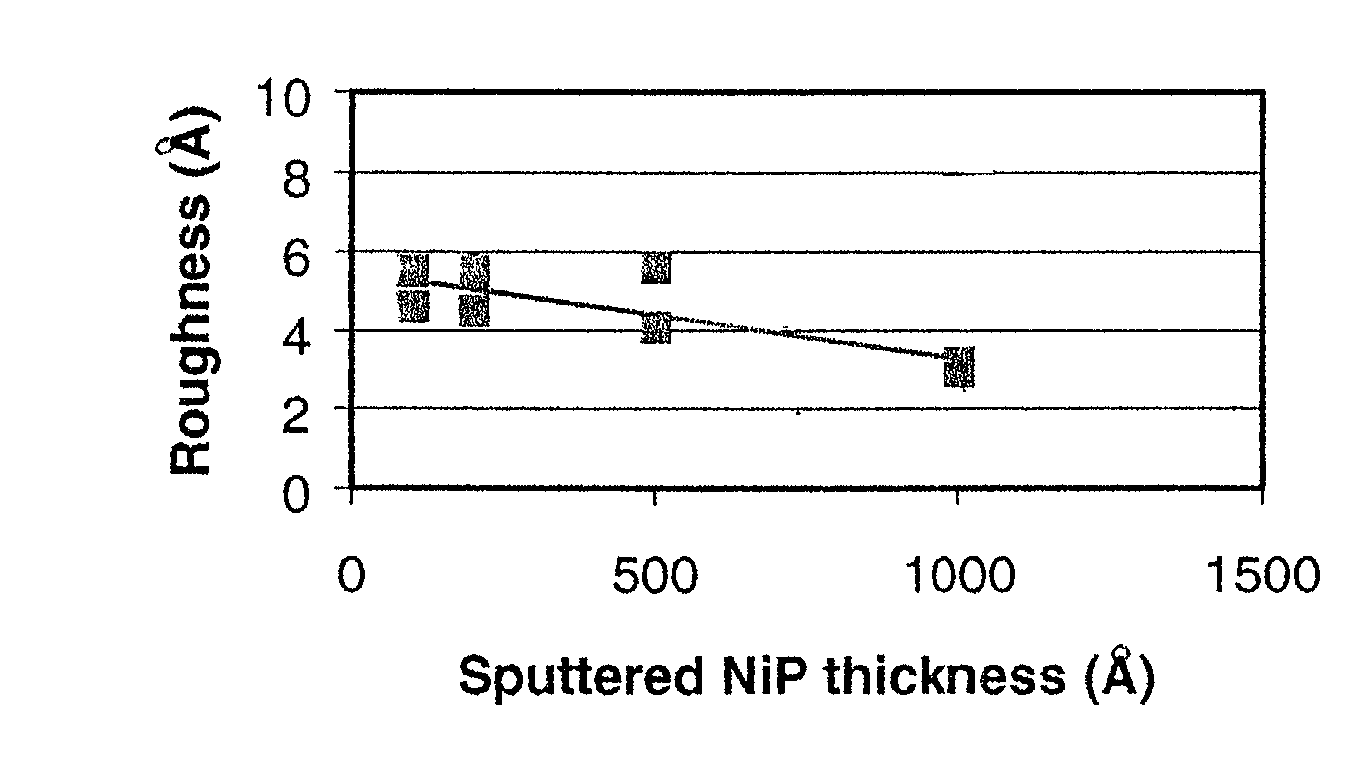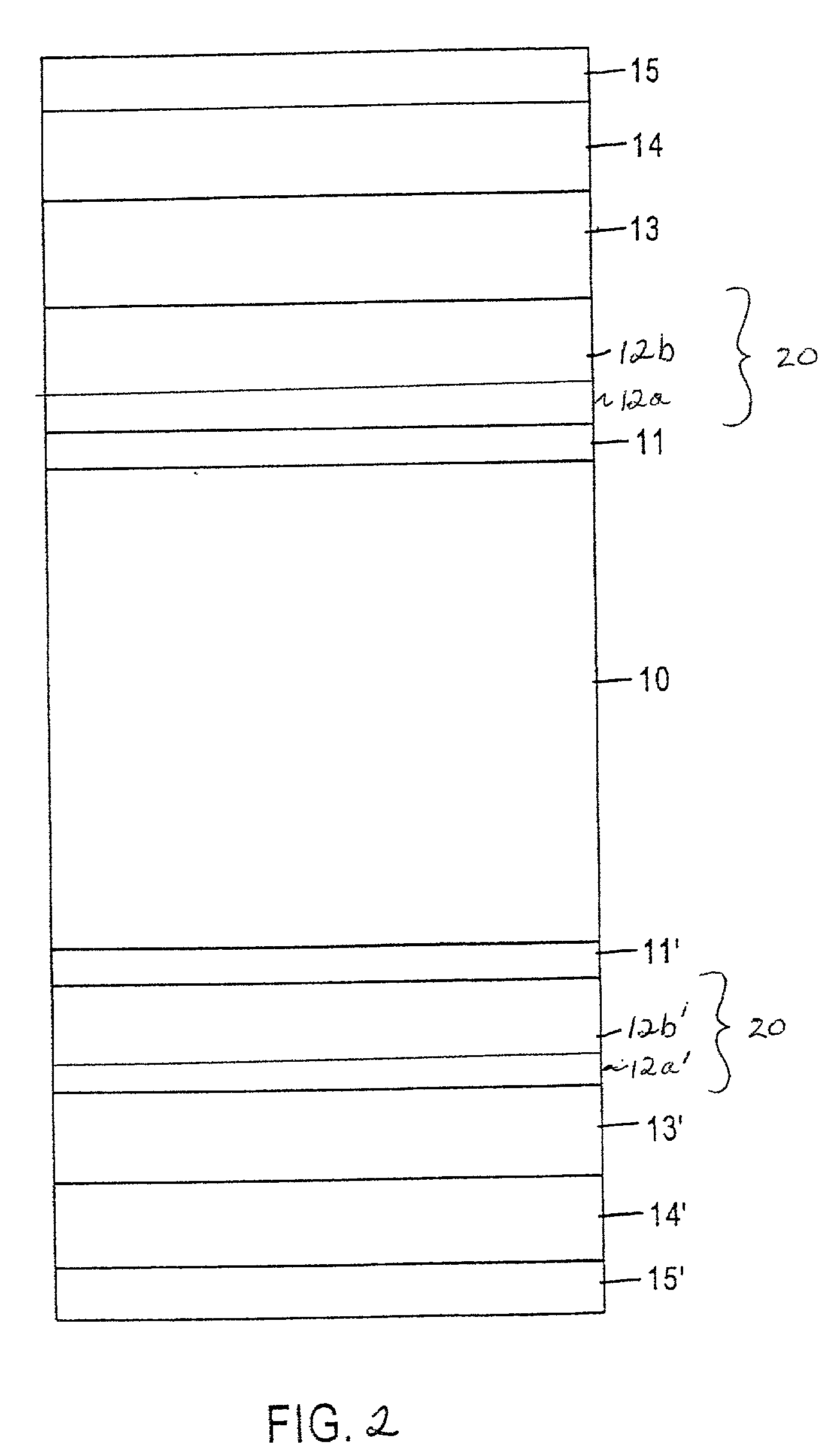Using plated surface for recording media without polishing
a technology of plated surface and recording media, which is applied in the direction of electrolytic organic material coating, superimposed coating process, instruments, etc., can solve the problems of adversely affecting the writing of information to the magnetic disk, achieve high degree of surface smoothness, facilitate the manufacture of magnetic recording media, and improve the overall process throughput
- Summary
- Abstract
- Description
- Claims
- Application Information
AI Technical Summary
Benefits of technology
Problems solved by technology
Method used
Image
Examples
example 2
[0034] A nickel phosphorus (NiP) composite coating was prepared. The NiP composite coating was prepared by sputtering a nickel-phosphorus (NiP) layer on a TiW coated Ohara TS-10 SXSP glass-ceramic disk. The NiP was sputtered from a NiP target comprising about 25 atomic % nickel. The sputter deposited NiP layer had a thickness of about 500 .ANG.. A 1 micron thick nickel phosphorus (NiP) layer was electrolessly deposited over the sputter deposited NiP layer. The NiP layer was electrolessly plated from an Enthone 6450 Ni plating bath.
[0035] The surface roughness of the as-deposited composite nickel layer was measured using AFM (Atomic Field Microscopy). A 10 micron.times.10 micron scan of the composite nickel coating indicated a surface roughness (Ra) of about 5.6 .ANG..
example 3
[0036] A nickel phosphorus (NiP) composite coating was prepared. The NiP composite coating was prepared by sputtering a nickel-phosphorus (NiP) layer on a TiW coated Ohara TS-10 SXSP glass-ceramic disk. The NiP was sputtered from a NiP target comprising about 25 atomic % nickel. The sputter deposited NiP layer had a thickness of about 200 .ANG.. A 1 micron thick nickel phosphorus (NiP) layer was electrolessly deposited over the sputter deposited NiP layer. The NiP layer was electrolessly plated from an Enthone 6450 Ni plating bath.
[0037] The surface roughness of the as-deposited composite nickel layer was measured using AFM (Atomic Field Microscopy). A 10 micron.times.10 micron scan of the composite nickel coating indicated a surface roughness (Ra) of about 5.5 .ANG..
example 4
[0038] A nickel phosphorus (NiP) composite coating was prepared. The NiP composite coating was prepared by sputtering a nickel-phosphorus (NiP) layer on a TiW coated Ohara TS-10 SXSP glass-ceramic disk. The NiP was sputtered from a NiP target comprising about 25 atomic % nickel. The sputter deposited NiP layer had a thickness of about 100 .ANG.. A 1 micron thick nickel phosphorus (NiP) layer was electrolessly deposited over the sputter deposited NiP layer. The NiP layer was electrolessly plated from an Enthone 6450 Ni plating bath.
[0039] The surface roughness of the as-deposited composite nickel layer was measured using AFM (Atomic Field Microscopy). A 10 micron.times.10 micron scan of the composite nickel coating indicated a surface roughness (Ra) of about 5.5 .ANG..
[0040] Referring again to FIG. 2, after the composite nickel coating 20 is formed on the substrate 10 the magnetic medium is deposited thereon. The magnetic medium typically includes an underlayer 13, 13', such as chrom...
PUM
| Property | Measurement | Unit |
|---|---|---|
| thickness | aaaaa | aaaaa |
| thickness | aaaaa | aaaaa |
| Ra | aaaaa | aaaaa |
Abstract
Description
Claims
Application Information
 Login to View More
Login to View More - R&D
- Intellectual Property
- Life Sciences
- Materials
- Tech Scout
- Unparalleled Data Quality
- Higher Quality Content
- 60% Fewer Hallucinations
Browse by: Latest US Patents, China's latest patents, Technical Efficacy Thesaurus, Application Domain, Technology Topic, Popular Technical Reports.
© 2025 PatSnap. All rights reserved.Legal|Privacy policy|Modern Slavery Act Transparency Statement|Sitemap|About US| Contact US: help@patsnap.com



